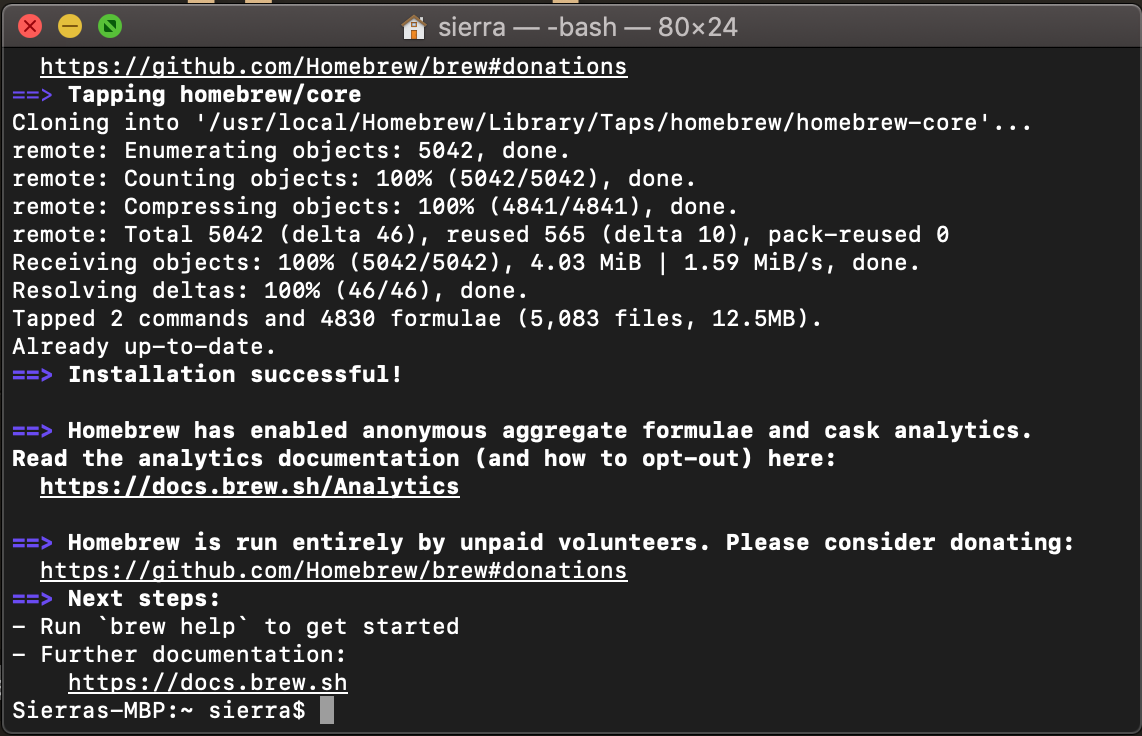

- #HOW TO INSTALL PYTHON ON MAC VIA HOMEBREW HOW TO#
- #HOW TO INSTALL PYTHON ON MAC VIA HOMEBREW MAC OS X#
- #HOW TO INSTALL PYTHON ON MAC VIA HOMEBREW UPDATE#
- #HOW TO INSTALL PYTHON ON MAC VIA HOMEBREW UPGRADE#
- #HOW TO INSTALL PYTHON ON MAC VIA HOMEBREW SOFTWARE#
Using Moshe's recommendation to use a version manager (pyenv) enables us to easily accept future upgrades without getting confused about which Python we are running at a given time.
#HOW TO INSTALL PYTHON ON MAC VIA HOMEBREW UPDATE#
Now we know for certain that we're using Python 3.7.3 and pip will update alongside it without any manual aliasing between versions. If command -v pyenv 1 >/dev /null 2 >& 1 then While other installation options are available, the easiest way to get started is with Homebrew: This tool manages multiple versions of Python and is described as "simple, unobtrusive, and follows the Unix tradition of single-purpose tools that do one thing well." How do we stop caring about the default? Moshe recommends using pyenv to manage Python environments (for a deeper dive on configuring pyenv, see this article).
#HOW TO INSTALL PYTHON ON MAC VIA HOMEBREW MAC OS X#
You do not want the Mac OS X 'default Python' to be 'python3.' You want to never care about default Python." "The basic premise of all Python development is to never use the system Python. He helped 40 colleagues develop Python safely and consistently on macOS systems following one core principle: I knew Moshe was familiar with Python, but what I didn't know is that he is an author of many Python tutorials as well as an upcoming book on Python development on macOS. Moshe Zadka cautions that doing this wrong could result in an unreliable idea of which Python is running that depends too closely on shells loading aliases.
#HOW TO INSTALL PYTHON ON MAC VIA HOMEBREW HOW TO#
Here's the full story of how to set up your environment without breaking anything built into the macOS operating system. To my surprise, I found only a handful of StackOverflow posts, and they pointed me to partial solutions. So, I did what any of us would do and googled around looking for a guide to update my development environment, which runs on Mac (the macOS operating system, formerly known as OS X). A future version of pip will drop support for Python 2.7.
#HOW TO INSTALL PYTHON ON MAC VIA HOMEBREW UPGRADE#
Please upgrade your Python as Python 2.7 won 't be maintained after that date.

We can check the versions of Python 2 and Python 3 installed on Mac using the following commands.Īfter checking the version, the next step is to check if any new version is available on the official website. brew install Python Using Python Installer for macOSīefore updating or installing Python on Mac using the Python installer, the first step is to check the installed version of Python on Mac. Using the following command, we can also install Python 2 on macOS. In case we have to use Python 2 to run a program, we can do so by indicating the default macOS Python binary path /usr/bin/python/ at the start of the code file, as shown below. echo "alias python=/usr/local/bin/python3.7" > ~/.bashrc Therefore, we can use an alias that will point to the Python version installed by Homebrew to run the Python scripts. cp /usr/local/bin/python3 /usr/local/bin/pythonīut the problem with the above method is that it will be a problem to run some legacy code using Python 2 in the future. Once Python 3 is installed, we can set is as default to run the programs, using the following command. We can also update the Python 3 version from 3.x to 3.y using the following command on the terminal. Once we have Homebrew, we can easily install Python on macOS using the following command on the terminal. If Homebrew is not installed on your Mac, you can install it from here.
#HOW TO INSTALL PYTHON ON MAC VIA HOMEBREW SOFTWARE#
It helps in installing and updating the software through the terminal. Homebrew is an open-source package manager software for macOS and Linux. And we can easily update Python on macOS using Homebrew. Therefore another way to update Python to the latest version is by using a single command. We will also discuss how to install the latest version of Python 3 or Python 2 on Mac.Īlthough the easiest way to update or install the latest version of Python on Mac is by using Python’s official website, we will have to check for future updates manually by checking the site again and again. In this tutorial, we will discuss different methods to update Python on Mac. Update Python Using Python Installer for macOS.


 0 kommentar(er)
0 kommentar(er)
